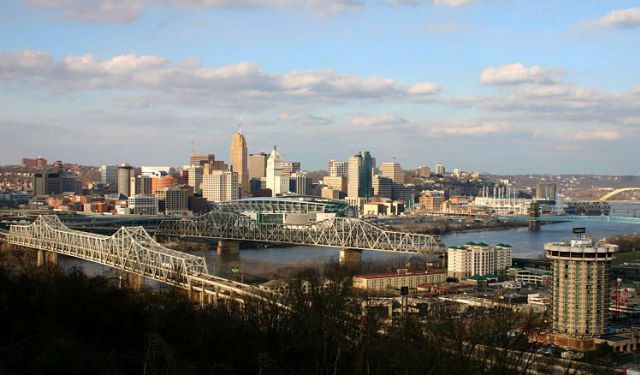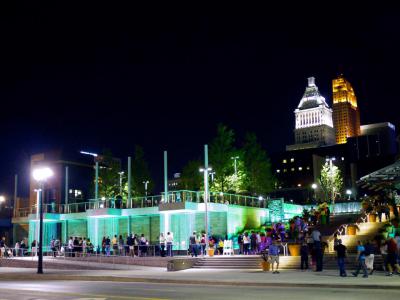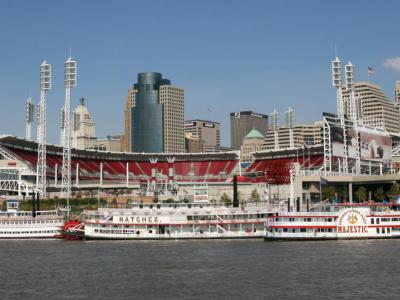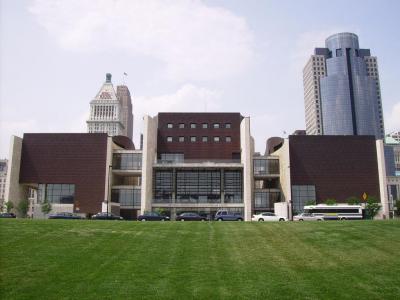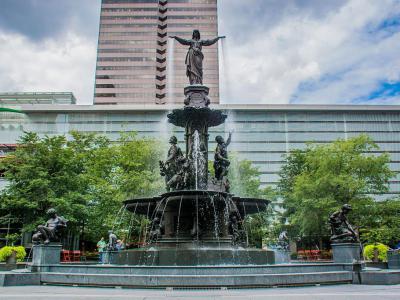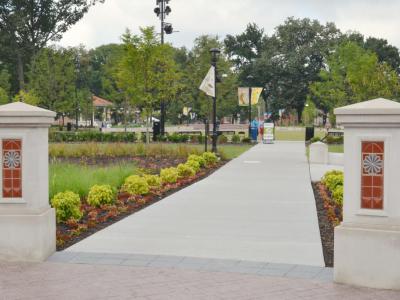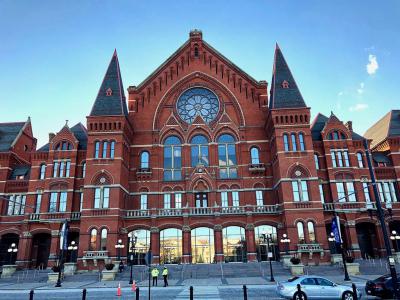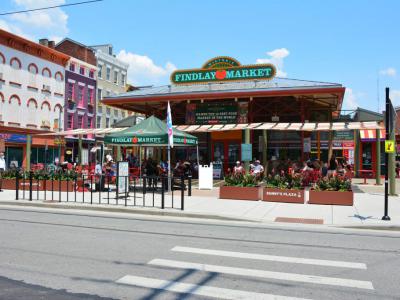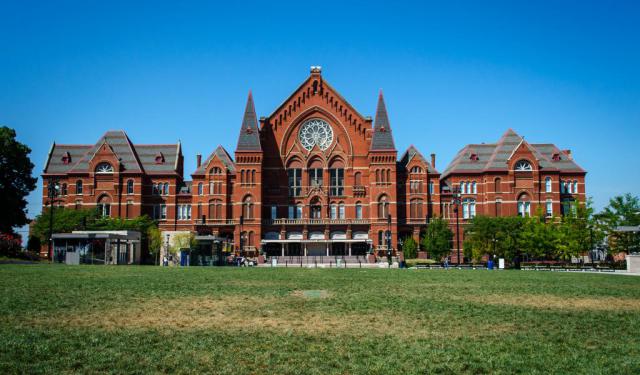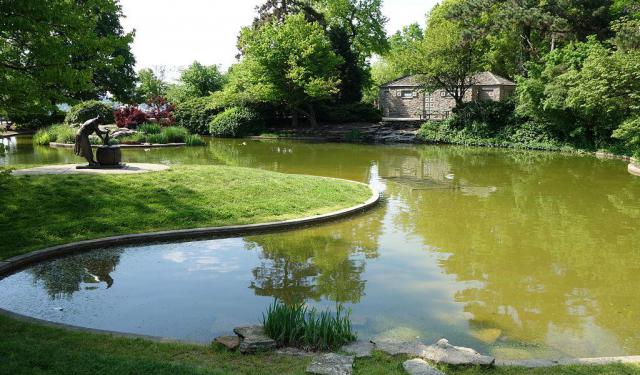Cincinnati Introduction Walking Tour (Self Guided), Cincinnati
Welcome to Cincinnati, Ohio-a place that blends historical richness with the vibrancy of cultural attractions!
The land that became Cincinnati had previously been occupied by Fort Washington. Before that, it was home to the Shawnee and other Native American tribes like the Miami, Ojibwe, and Lenape.
Founded in 1788, the city earned its name from the Society of the Cincinnati, the nation's oldest patriotic group formed by American Revolutionary War officers. Honoring both, the Society and its members who settled in the Northwest Territory, this name pays homage to Cincinnatus, the Roman hero honored for his civic virtue and selfless leadership. Similarly to Cincinnatus, who saved the country from a crisis and then voluntarily retired to farming, George Washington – likened to Cincinnatus for his leadership and humility – declined to run for a third term of office in 1796. Upon his retirement, he devoted time to his plantations and other business interests.
The early white settlers in the area were primarily veterans of the Revolutionary War. Granted the land, some stayed on it and some sold it for profit. The location proved to be popular, seeing the number of settlers grow from 1,000 in 1803 to 10,000 by 1820. Over time, Cincinnati has evolved into a dynamic urban center with a deep historical footprint.
Undoubtedly, one of its most important roles was as a stop along the Underground Railroad. The National Underground Railroad Freedom Center honors the legacy of this railroad and highlights the ongoing struggle for freedom and equality. It’s a powerful reminder of Cincinnati’s role in the fight against slavery.
After the Civil War, the city stood at the forefront of engineering feats. The Roebling Suspension Bridge, erected in 1866, was the longest suspension bridge in the world. Today, this iconic structure is thought of as a technological marvel that paved the way for changes in the design of bridges.
Tourists to Cincinnati will find a number of other important stops on their walking tour. Stroll down to Smale Riverfront Park, where you can enjoy beautifully landscaped gardens, interactive water features, and scenic river views. It’s an excellent spot to unwind and soak in the city’s ambiance.
In the heart of downtown, Fountain Square serves as a vibrant hub for community events and entertainment. And if you’re in the mood for a local market experience, Findlay Market offers a bustling atmosphere with diverse food vendors, fresh produce, and artisanal goods.
Cincinnati is a city where history meets modernity, with no shortage of attractions promising an enriching experience. So, pack your bags and set out on an adventure to discover what this unique city has to offer-there’s a whole lot waiting to be explored!
The land that became Cincinnati had previously been occupied by Fort Washington. Before that, it was home to the Shawnee and other Native American tribes like the Miami, Ojibwe, and Lenape.
Founded in 1788, the city earned its name from the Society of the Cincinnati, the nation's oldest patriotic group formed by American Revolutionary War officers. Honoring both, the Society and its members who settled in the Northwest Territory, this name pays homage to Cincinnatus, the Roman hero honored for his civic virtue and selfless leadership. Similarly to Cincinnatus, who saved the country from a crisis and then voluntarily retired to farming, George Washington – likened to Cincinnatus for his leadership and humility – declined to run for a third term of office in 1796. Upon his retirement, he devoted time to his plantations and other business interests.
The early white settlers in the area were primarily veterans of the Revolutionary War. Granted the land, some stayed on it and some sold it for profit. The location proved to be popular, seeing the number of settlers grow from 1,000 in 1803 to 10,000 by 1820. Over time, Cincinnati has evolved into a dynamic urban center with a deep historical footprint.
Undoubtedly, one of its most important roles was as a stop along the Underground Railroad. The National Underground Railroad Freedom Center honors the legacy of this railroad and highlights the ongoing struggle for freedom and equality. It’s a powerful reminder of Cincinnati’s role in the fight against slavery.
After the Civil War, the city stood at the forefront of engineering feats. The Roebling Suspension Bridge, erected in 1866, was the longest suspension bridge in the world. Today, this iconic structure is thought of as a technological marvel that paved the way for changes in the design of bridges.
Tourists to Cincinnati will find a number of other important stops on their walking tour. Stroll down to Smale Riverfront Park, where you can enjoy beautifully landscaped gardens, interactive water features, and scenic river views. It’s an excellent spot to unwind and soak in the city’s ambiance.
In the heart of downtown, Fountain Square serves as a vibrant hub for community events and entertainment. And if you’re in the mood for a local market experience, Findlay Market offers a bustling atmosphere with diverse food vendors, fresh produce, and artisanal goods.
Cincinnati is a city where history meets modernity, with no shortage of attractions promising an enriching experience. So, pack your bags and set out on an adventure to discover what this unique city has to offer-there’s a whole lot waiting to be explored!
How it works: Download the app "GPSmyCity: Walks in 1K+ Cities" from Apple App Store or Google Play Store to your mobile phone or tablet. The app turns your mobile device into a personal tour guide and its built-in GPS navigation functions guide you from one tour stop to next. The app works offline, so no data plan is needed when traveling abroad.
Cincinnati Introduction Walking Tour Map
Guide Name: Cincinnati Introduction Walking Tour
Guide Location: USA » Cincinnati (See other walking tours in Cincinnati)
Guide Type: Self-guided Walking Tour (Sightseeing)
# of Attractions: 8
Tour Duration: 2 Hour(s)
Travel Distance: 3.0 Km or 1.9 Miles
Author: DanaOffice
Sight(s) Featured in This Guide:
Guide Location: USA » Cincinnati (See other walking tours in Cincinnati)
Guide Type: Self-guided Walking Tour (Sightseeing)
# of Attractions: 8
Tour Duration: 2 Hour(s)
Travel Distance: 3.0 Km or 1.9 Miles
Author: DanaOffice
Sight(s) Featured in This Guide:
- Roebling Suspension Bridge
- Smale Riverfront Park
- Cincinnati Reds Hall of Fame & Museum
- National Underground Railroad Freedom Center
- Fountain Square
- Washington Park
- Music Hall
- Findlay Market
1) Roebling Suspension Bridge (must see)
The John A. Roebling Suspension Bridge crosses the Ohio River between Cincinnati and Covington, Kentucky. The bridge is known for being the longest suspension bridge in the world when it was originally built in 1866.
The Covington and Cincinnati Bridge Company formed in 1846 for the sole purpose of building this bridge. Though the company was greeted with much opposition from the outset, construction finally began in 1856. John A. Roebling was the architect hired for this job as his previous work, including the Niagara Falls Suspension Bridge, had shown that he was able to design a bridge of the substantial length required.
Previously known as the Cincinnati-Covington Bridge, the Roebling Suspension Bridge is 1,642 feet and 11 inches in length. It no longer sees the heavy vehicle transit that it once did, but it continues to be a popular pedestrian bridge. Visitors can enjoy views of the Ohio River while on their way to or from the Great American Ballpark, Paul Brown Stadium and the National Underground Railroad Freedom Center.
The Covington and Cincinnati Bridge Company formed in 1846 for the sole purpose of building this bridge. Though the company was greeted with much opposition from the outset, construction finally began in 1856. John A. Roebling was the architect hired for this job as his previous work, including the Niagara Falls Suspension Bridge, had shown that he was able to design a bridge of the substantial length required.
Previously known as the Cincinnati-Covington Bridge, the Roebling Suspension Bridge is 1,642 feet and 11 inches in length. It no longer sees the heavy vehicle transit that it once did, but it continues to be a popular pedestrian bridge. Visitors can enjoy views of the Ohio River while on their way to or from the Great American Ballpark, Paul Brown Stadium and the National Underground Railroad Freedom Center.
2) Smale Riverfront Park (must see)
Smale Riverfront Park is a park located on the bank of the Ohio River between Paul Brown Stadium and the Great American Ballpark. The park connects Bicentennial Commons and Sawyer Point to create almost three miles of green space along the river.
Smale Riverfront Park was created through a $20 million gift from John G. Smale, former CEO of Procter & Gamble. He gifted the funds for the park in honor of his wife, Phyllis.
Construction on the park began in 2008. It opened to the public in May 2012 though construction was not completed until 2015. The 40 acres of park include bike and walking trails, boat docks, playgrounds, water features, a promenade, festival space and a carousel.
Tourists of the city enjoy Smale Riverfront Park for the spectacular views of the river and easy access to downtown Cincinnati. It is a good stopping place while visiting Cincinnati's numerous historic sites and entertainment venues.
Smale Riverfront Park was created through a $20 million gift from John G. Smale, former CEO of Procter & Gamble. He gifted the funds for the park in honor of his wife, Phyllis.
Construction on the park began in 2008. It opened to the public in May 2012 though construction was not completed until 2015. The 40 acres of park include bike and walking trails, boat docks, playgrounds, water features, a promenade, festival space and a carousel.
Tourists of the city enjoy Smale Riverfront Park for the spectacular views of the river and easy access to downtown Cincinnati. It is a good stopping place while visiting Cincinnati's numerous historic sites and entertainment venues.
3) Cincinnati Reds Hall of Fame & Museum
Located next to the Great American Ballpark, the Cincinnati Reds Hall of Fame & Museum offers photographs and displays from throughout the history of Cincinnati's Major League Baseball team.
The Cincinnati Reds Hall of Fame was established in 1958. Every other year, players, managers and executives are inducted into the Cincinnati Reds Hall of Fame. These inductees are voted on by the Baseball Writers' Association of America.
The Hall of Fame Museum was opened in 2004. Items on display date all the way back to 1869 when the Cincinnati Red Stockings were newly formed. Other items featured in exhibits include Topps trading cards, artifacts from the 1919 World Series, jerseys from the Cincinnati Tigers and each of the World Series trophies that have been earned by the team.
Visitors will see the Hall of Fame Gallery that features touchscreen to display more information about each of the inductees. Tourists will see images of such baseball greats as Frank Robinson, Johnny Bench, Barry Larkin, Ken Griffey Jr. and Ernie Lombardi.
The Cincinnati Reds Hall of Fame was established in 1958. Every other year, players, managers and executives are inducted into the Cincinnati Reds Hall of Fame. These inductees are voted on by the Baseball Writers' Association of America.
The Hall of Fame Museum was opened in 2004. Items on display date all the way back to 1869 when the Cincinnati Red Stockings were newly formed. Other items featured in exhibits include Topps trading cards, artifacts from the 1919 World Series, jerseys from the Cincinnati Tigers and each of the World Series trophies that have been earned by the team.
Visitors will see the Hall of Fame Gallery that features touchscreen to display more information about each of the inductees. Tourists will see images of such baseball greats as Frank Robinson, Johnny Bench, Barry Larkin, Ken Griffey Jr. and Ernie Lombardi.
4) National Underground Railroad Freedom Center (must see)
The National Underground Railroad Freedom Center is a museum that covers the origins and history of the underground railroad. It is located near the banks of the Ohio River as many enslaved people found their freedom by crossing the river and seeking refuge in Cincinnati.
Construction of the museum began in 2002. Groundbreaking ceremonies were attended by Oprah Winfrey, Muhammad Ali and First Lady Michelle Obama. It was designed by Boora Architects with a travertine stone and copper facade.
Among the exhibits in the museum is an 1830 slave pen. This is the only known surviving slave pen, which was a building used to hold enslaved people before they were auctioned. The pen is a primary feature and constant reminder of the horror of slavery.
Other features in the National Underground Railroad Freedom Center include exhibits of slavery and the civil war, films detailing the experiences and history of the underground railroad and an interactive exhibit that encourages young visitors to imagine the choices that were needed to escape slavery in the southern United States.
The National Underground Railroad Freedom Center encourages patrons to understand their past as well as their future. The museum has a genealogy center that encourages individuals to find family members who may have been a part of the Underground Railroad. A feature called "The Struggle Continues" reminds visitors that African Americans continue to face racial injustice to this day.
Visitors should plan to spend several hours at the National Underground Railroad Freedom Center in order to see and understand each of the displays. Even young children are affected by the importance of the Underground Railroad.
Why You Should Visit:
- To learn about the history of the Underground Railroad
- To see the only known surviving slave jail
- To learn how to continue fighting for racial equality
Construction of the museum began in 2002. Groundbreaking ceremonies were attended by Oprah Winfrey, Muhammad Ali and First Lady Michelle Obama. It was designed by Boora Architects with a travertine stone and copper facade.
Among the exhibits in the museum is an 1830 slave pen. This is the only known surviving slave pen, which was a building used to hold enslaved people before they were auctioned. The pen is a primary feature and constant reminder of the horror of slavery.
Other features in the National Underground Railroad Freedom Center include exhibits of slavery and the civil war, films detailing the experiences and history of the underground railroad and an interactive exhibit that encourages young visitors to imagine the choices that were needed to escape slavery in the southern United States.
The National Underground Railroad Freedom Center encourages patrons to understand their past as well as their future. The museum has a genealogy center that encourages individuals to find family members who may have been a part of the Underground Railroad. A feature called "The Struggle Continues" reminds visitors that African Americans continue to face racial injustice to this day.
Visitors should plan to spend several hours at the National Underground Railroad Freedom Center in order to see and understand each of the displays. Even young children are affected by the importance of the Underground Railroad.
Why You Should Visit:
- To learn about the history of the Underground Railroad
- To see the only known surviving slave jail
- To learn how to continue fighting for racial equality
5) Fountain Square (must see)
Fountain Square is considered to be the heart of Cincinnati. The city square was founded in 1871 in what was then the center of the city. The plaza is in the midst of downtown Cincinnati and is surrounded by shops, restaurants and hotels.
The defining feature of Fountain Square is the fountain itself. The Tyler Davidson Fountain, also known as The Genius of Water, is one of the most visited attractions in the city. It was a gift to the city from Henry Probasco in honor of his business partner and brother-in-law, Tyler Davidson.
The bronze-cast fountain is 43 feet tall. It features a nine-foot cast of a woman with her arms outstretched and four representations of the uses of water. An inscription on the fountain reads "To the People of Cincinnati."
Fountain Square is an easy walk from a number of other locations in Cincinnati. It is only minutes away by foot from the National Underground Railroad Freedom Center and Smale Riverfront Park.
The defining feature of Fountain Square is the fountain itself. The Tyler Davidson Fountain, also known as The Genius of Water, is one of the most visited attractions in the city. It was a gift to the city from Henry Probasco in honor of his business partner and brother-in-law, Tyler Davidson.
The bronze-cast fountain is 43 feet tall. It features a nine-foot cast of a woman with her arms outstretched and four representations of the uses of water. An inscription on the fountain reads "To the People of Cincinnati."
Fountain Square is an easy walk from a number of other locations in Cincinnati. It is only minutes away by foot from the National Underground Railroad Freedom Center and Smale Riverfront Park.
6) Washington Park
Located in the heart of Cincinnati’s Over-the-Rhine neighborhood, Washington Park is a six-acre urban oasis nestled between Elm and Race Streets, just east of the iconic Cincinnati Music Hall. Though smaller in size than Eden Park, it’s arguably the city’s most beloved and vibrant green space.
Families flock here for the playground, which features a whimsical play castle, climbing wall, sandboxes, and slides. On hot days, kids cool off at the interactive splash pad with over 130 pop-up water jets. Dog lovers can enjoy the 12,000-square-foot dog park, complete with synthetic turf and a water fountain for four-legged visitors.
Cultural elements add unique charm to the park. The American Classical Music Walk of Fame pays tribute to music legends like Leonard Bernstein, Duke Ellington, and Scott Joplin with engraved pavement stones and a choreographed dancing fountain that plays along to classical melodies. There’s also a historic bandstand gazebo, which hosts regular concerts and festivals throughout the year.
History buffs will appreciate the Civil War memorials scattered throughout the park, including cannons and busts of Union figures like Frederick Hecker and Colonel Robert Latimer McCook of the German 9th Ohio Infantry ("Die Neuner"). A bronze tablet, gifted in 1931 by the descendants of the 9th O.V.I., also honors this legacy.
Whether you’re in town for a performance at Music Hall, looking for a family-friendly afternoon, or just want to stretch your legs under the shade of century-old trees, Washington Park offers a mix of leisure, history, and culture that makes it a true Cincinnati gem.
Families flock here for the playground, which features a whimsical play castle, climbing wall, sandboxes, and slides. On hot days, kids cool off at the interactive splash pad with over 130 pop-up water jets. Dog lovers can enjoy the 12,000-square-foot dog park, complete with synthetic turf and a water fountain for four-legged visitors.
Cultural elements add unique charm to the park. The American Classical Music Walk of Fame pays tribute to music legends like Leonard Bernstein, Duke Ellington, and Scott Joplin with engraved pavement stones and a choreographed dancing fountain that plays along to classical melodies. There’s also a historic bandstand gazebo, which hosts regular concerts and festivals throughout the year.
History buffs will appreciate the Civil War memorials scattered throughout the park, including cannons and busts of Union figures like Frederick Hecker and Colonel Robert Latimer McCook of the German 9th Ohio Infantry ("Die Neuner"). A bronze tablet, gifted in 1931 by the descendants of the 9th O.V.I., also honors this legacy.
Whether you’re in town for a performance at Music Hall, looking for a family-friendly afternoon, or just want to stretch your legs under the shade of century-old trees, Washington Park offers a mix of leisure, history, and culture that makes it a true Cincinnati gem.
7) Music Hall
Music Hall is Cincinnati's performance hall for classical arts. Music Hall is the venue for the Cincinnati Ballet, Symphony Orchestra, Opera and Pops Orchestra.
The building was completed in 1878. It was designed by Samuel Hannaford in the Victorian Gothic Revival Architectural Style. It is distinctive from other performance halls in that the building is actually three separate buildings: Music Hall and the North and South Exposition Buildings.
The buildings feature sandstone carvings, a pitched gable roof and a large rose window. Music Hall originally had intricately carved brickwork, but most of the details were destroyed during a renovation of the building.
Those who enjoy sites that are reputed to be haunted should pay particular interest to Music Hall. It is said to be one of the most haunted places in America due to the fact that it was built over a pauper's cemetery.
Music Hall was named a National Historic Landmark in 1975. It has also been placed on the list of America's 11 most endangered historic places.
The building was completed in 1878. It was designed by Samuel Hannaford in the Victorian Gothic Revival Architectural Style. It is distinctive from other performance halls in that the building is actually three separate buildings: Music Hall and the North and South Exposition Buildings.
The buildings feature sandstone carvings, a pitched gable roof and a large rose window. Music Hall originally had intricately carved brickwork, but most of the details were destroyed during a renovation of the building.
Those who enjoy sites that are reputed to be haunted should pay particular interest to Music Hall. It is said to be one of the most haunted places in America due to the fact that it was built over a pauper's cemetery.
Music Hall was named a National Historic Landmark in 1975. It has also been placed on the list of America's 11 most endangered historic places.
8) Findlay Market (must see)
Findlay Market is the oldest continually operated public market in the city. The original Findlay Market was founded in 1852. It was located on land owned by James and Jane Irwin Findlay. It has been named one of the top 10 public markets in the world by "Newsweek" magazine.
The market features full-time vendors who sell meat, fish, flowers, produce, cheese, bakery items, beverages and other food items. There are also vendors who sell artisan crafts like candles, home decor, soaps and pottery.
From March through December, a farmer's market opens at Findlay Market on weekends. Along with the regular vendors, the farmer's market features outdoor vendors and street performers.
Unlike many other public markets in the United States, Findlay market is open year-round. Visitors can shop from 10 AM to 4 PM on Sundays, from 8 AM to 6 PM on Saturdays and from 9 AM to 6 PM during weekdays. The market is closed on Mondays.
The market features full-time vendors who sell meat, fish, flowers, produce, cheese, bakery items, beverages and other food items. There are also vendors who sell artisan crafts like candles, home decor, soaps and pottery.
From March through December, a farmer's market opens at Findlay Market on weekends. Along with the regular vendors, the farmer's market features outdoor vendors and street performers.
Unlike many other public markets in the United States, Findlay market is open year-round. Visitors can shop from 10 AM to 4 PM on Sundays, from 8 AM to 6 PM on Saturdays and from 9 AM to 6 PM during weekdays. The market is closed on Mondays.
Walking Tours in Cincinnati, Ohio
Create Your Own Walk in Cincinnati
Creating your own self-guided walk in Cincinnati is easy and fun. Choose the city attractions that you want to see and a walk route map will be created just for you. You can even set your hotel as the start point of the walk.
Over-the-Rhine District Walking Tour
The historic Over-The-Rhine (OTR) neighborhood is one of the largest districts in the U.S. recognized by the National Register of Historic Places. Its name comes from the predominantly German immigrants who developed the area in the mid-19th century and had to commute across bridges over the Miami and Erie Canal (nicknamed "the Rhine" in reference to the river in Germany) which separated... view more
Tour Duration: 1 Hour(s)
Travel Distance: 2.0 Km or 1.2 Miles
Tour Duration: 1 Hour(s)
Travel Distance: 2.0 Km or 1.2 Miles
Cincinnati's Historical Buildings
A place where remarkable landmarks, river views and rolling hills are all part of the cityscape, Cincinnati, OH is a home to one of the most impressive collections of historic architecture in the United States. German homes, French cathedrals and splendid 19th-century mansions are found here in abundance. The list of architectural styles present in the city is truly impressive and includes Greek-,... view more
Tour Duration: 2 Hour(s)
Travel Distance: 3.8 Km or 2.4 Miles
Tour Duration: 2 Hour(s)
Travel Distance: 3.8 Km or 2.4 Miles
Eden Park Walking Tour
Eden Park is undoubtedly the most popular park in Cincinnati, Ohio. This large outdoor area blends culture, history, and architecture in one stunning location. The park spans across lush greenery and scenic spots, making it a beloved retreat for locals and tourists alike. Apart from offering a tranquil escape amidst the urban bustle, Eden Park is also home to a number of famous city landmarks.
... view more
Tour Duration: 2 Hour(s)
Travel Distance: 2.5 Km or 1.6 Miles
... view more
Tour Duration: 2 Hour(s)
Travel Distance: 2.5 Km or 1.6 Miles
The Most Popular Cities
/ view all
